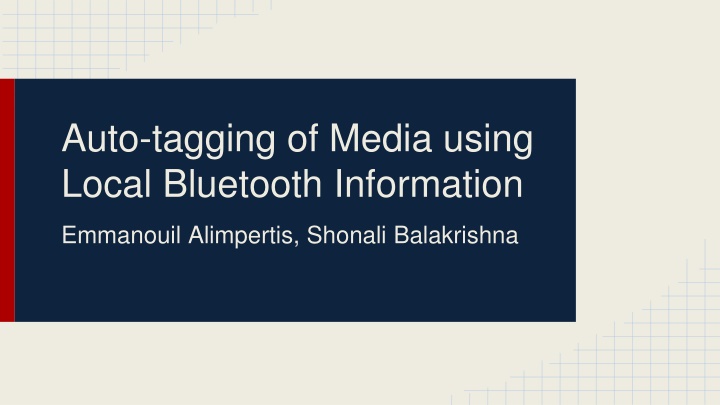
Auto-Tagging of Media Using Local Bluetooth Information
"Explore the innovative system architecture and evaluation of auto-tagging media using local Bluetooth information. Learn about the motivation, challenges, and necessity for immediate tagging and sharing of photos based on proximity data. See the results and advancements in this cutting-edge technology." (Characters: 499)
Uploaded on | 0 Views
Download Presentation

Please find below an Image/Link to download the presentation.
The content on the website is provided AS IS for your information and personal use only. It may not be sold, licensed, or shared on other websites without obtaining consent from the author. If you encounter any issues during the download, it is possible that the publisher has removed the file from their server.
You are allowed to download the files provided on this website for personal or commercial use, subject to the condition that they are used lawfully. All files are the property of their respective owners.
The content on the website is provided AS IS for your information and personal use only. It may not be sold, licensed, or shared on other websites without obtaining consent from the author.
E N D
Presentation Transcript
Auto-tagging of Media using Local Bluetooth Information Emmanouil Alimpertis, Shonali Balakrishna
Motivation & Related Work Photos volume has been exploded due to use of smartphones. Difficult for users to keep track of media generated of them. Challenges: Photos are taken by many people at different events, making sharing difficult. Necessity: a platform that allows immediate tagging and sharing of media, based on proximity information. There is no widely known App for auto-tagging media during events. Bluetooth (BT) proximity is considered for several applications; however, no work exists for auto-tagging of media to help users keep track of and share photos. Related project: A. Pullabhatla & H. Gomes, Proximity Data Gathering for Android Through Bluetooth , CSE 237B, UC San Diego, Fall 2009.
System Architecture 1. Android Application: i) Scans for BT Proximity Devices ii) Tags photo on capture iii) Saves data locally in ORMLite DB. iv) Uploads to Web Server using REST v) Share URL with Participants with BT. 1. Bluetooth Android APIs were used for proximity discovery of participants and for media URL sharing. 2. ORMLite was used as the relational mapper to persist objects to database to store the schema. 3. REST API was used to upload photo to a HTTP web server running PHP. Server responds with a public URL
Evaluation & Use Cases Application was evaluated using two Android devices, to send upload URL s of generated media. Basic Use Case: i) Use Bluetooth to detect proximity devices (i.e. your friends) ii) Create an event with location and duration. iii) On creation of media, associate media with an event, upload to server and generate a URL iv) Using Bluetooth, scan for friends and send a request for a tag. iii) After acceptance, communicate media tag information and shares the URL with the participants.
